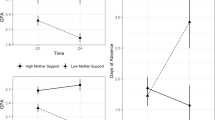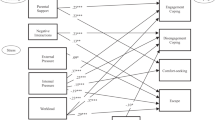Abstract
Using a risk and resiliency theoretical framework, the association between interparental conflict and academic achievement was examined. The sample consisted of 2,297 6th grade youth with a mean age of 11.92. Participants were mostly European American (81.8%) and 52% were girls. Results demonstrated that interparental conflict is a risk factor for lower academic achievement, suggesting that family interactions play a significant role in how youth perform in the academic setting. Youth self-blame acted as a significant mediator, providing some explanation for how interparental conflict affects academic achievement. Maternal acceptance and monitoring knowledge partially buffered the association between interparental conflict and youth self-blame. Additionally, the positive association between interparental conflict and perceived threat was stronger for youth who perceived relationships with mothers as more supportive, connected, and involved. Results from this study underscore the need for continued focus on the link between family and school environments with respect to youth developmental outcomes.



Similar content being viewed by others
References
Achenbach, T. M. (1991). Manual for the child behavior checklist/4–18 and 1991 Profile. Burlington, VT: University of Vermont Department of Psychiatry.
Acock, A. (2005). Working with missing values. Journal of Marriage and the Family, 67, 1012–1028. doi:10.1111/j.1741-3737.2005.00191.x.
Aiken, L. S., & West, S. G. (1991). Multiple regression: Testing and interpreting interactions. Thousand Oaks, CA: Sage Publications.
Barber, B. K., Stoltz, H. E., & Olsen, J. A. (2005). Parental support, psychological control, and behavioral control: Assessing relevance across time, culture, and method. Monographs of the Society for Research in Child Development, 70(4, Serial No. 282).
Brown, B. B., Mounts, N., Lamborn, S. D., & Steinberg, L. (1993). Parenting practices and peer group affiliation in adolescence. Child Development, 64, 78–92. doi:10.2307/1131263.
Browne, M. W., & Cudeck, R. (1993). Alternative ways of assessing model fit. In K. A. Bollen & J. S. Long (Eds.), Testing structural equation models (pp. 136–162). Newbury Park, CA: Sage Publications.
Bueher, C., Krishnakumar, A., Stone, G., Anthony, C., Pemberton, S., Gerard, J., et al. (1998). Interparental conflict styles and youth problem behavior: A two-sample replication study. Journal of Marriage and the Family, 60, 119–132. doi:10.2307/353446.
Buehler, C., Anthony, C., Krishnakumar, A., Stone, G., Gerard, J., & Pemberton, S. (1997). Interparental conflict and youth problem behaviors: A meta-analysis. Journal of Child and Family Studies, 6, 233–247. doi:10.1023/A:1025006909538.
Buehler, C., Lange, G., & Franck, K. L. (2007). Adolescents’ cognitive and emotional responses to marital hostility. Child Development, 78, 775–789. doi:10.1111/j.1467-8624.2007.01032.x.
Byrne, B. M. (2004). Testing for multigroup invariance using AMOS graphics: A road less traveled. Structural Equation Modeling, 11, 272–300. doi:10.1207/s15328007sem1102_8.
Call, K. T., & Mortimer, J. T. (2001). Arenas of comfort in adolescence: A study of adjustment in context. Mahwah, NJ: Lawrence Erlbaum Associates.
Clarke-Stewart, A. (2006). What have we learned: Proof that families matter, policies for families and children, prospects for future research. In A. Clarke-Stewart & J. Dunn (Eds.), Families count: Effects on child and adolescent development (pp. 321–336). New York, NY: Cambridge University Press.
Connell, J. P., Halpern-Felsher, B. L., Clifford, E., Crichlow, W., & Usinger, P. (1995). Hanging in there: Behavioral, psychological, and contextual factors affecting whether African American adolescents stay in high school. Journal of Adolescent Research, 10, 41–63. doi:10.1177/0743554895101004.
Conway, J. M. (2004). Method variance and method bias in industrial and organizational psychology. In S. G. Rogelberg (Ed.), Handbook of research methods in industrial and organizational psychology (pp. 344–365). Malden, MA: Blackwell Publishers.
Davies, P. T., Harold, G. T., Goeke-Morey, M. C., & Cummings, E. M. (2002). Child emotional security and interparental conflict. Monographs of the Society for Research in Child Development, 67(3, Serial No. 270).
Davies, P. T., & Lindsay, L. L. (2004). Interparental conflict and adolescent adjustment: Why does gender moderate early adolescent vulnerability? Journal of Family Psychology, 18, 160–170. doi:10.1037/0893-3200.18.1.160.
Elder, G. H., & Conger, R. D. (2000). Children of the land: Adversity and success in rural America. Chicago, IL: University of Chicago Press.
Frederickson, N., & Petrides, K. V. (2008). Ethnic, gender, and socio-economic group differences in academic performance and secondary school selection: A longitudinal analysis. Learning and Individual Differences, 18, 144–151. doi:10.1016/j.lindif.2005.09.001.
Fritz, M. S., & MacKinnon, D. P. (2007). Required sample size to detect the mediated effect. Psychological Science, 18, 233–239. doi:10.1111/j.1467-9280.2007.01882.x.
Garmezy, N. (1981). Children under stress: Perspectives on antecedents and correlates of vulnerability and resistance to psychopathology. In A. I. Rabin, J. Aronoff, A. M. Barclay, & R. A. Zucker (Eds.), Further explorations in personality (pp. 196–269). New York: John Wiley & Sons.
Gerard, J. M., Buehler, C., Franck, K., & Anderson, O. (2005). In the eyes of the beholder: Cognitive appraisals as mediators of the association between interparental conflict and youth maladjustment. Journal of Family Psychology, 19, 376–384. doi:10.1037/0893-3200.19.3.376.
Gomez, R., & McLaren, S. (2006). The association of avoidance coping style, and perceived mother and father support with anxiety/depression among late adolescents: Applicability of resiliency models. Personality and Individual Differences, 40, 1165–1176. doi:10.1016/j.paid.2005.11.009.
Grant, K. E., Compas, B. E., Thurm, A. E., McMahon, S. D., Gipson, P. Y., Campbell, A. J., et al. (2006). Stressors and child and adolescent psychopathology: Evidence of moderating and mediating effects. Clinical Psychology Review, 26, 257–283. doi:10.1016/j.cpr.2005.06.011.
Grych, J. H., Fincham, F. D., Jouriles, E. N., & McDonald, R. (2000). Interparental conflict and child adjustment: Testing the mediational role of appraisals in the cognitive-contextual framework. Child Development, 71, 1648–1661. doi:10.1111/1467-8624.00255.
Grych, J. H., Harold, G. T., & Miles, C. J. (2003). A prospective investigation of appraisals as mediators of the link between interparental conflict and child adjustment. Child Development, 74, 1176–1193. doi:10.1111/1467-8624.00600.
Grych, J. H., Raynor, S. R., & Fosco, G. M. (2004). Family processes that shape the impact of interparental conflict on adolescents. Development and Psychopathology, 16, 649–665. doi:10.1017/S0954579404004717.
Grych, J. H., Seid, M., & Fincham, F. D. (1992). Assessing marital conflict from the child’s perspective: The children’s perception of interparental conflict scale. Child Development, 63, 558–572. doi:10.2307/1131346.
Harold, G. T., Aitken, J. J., & Shelton, K. H. (2007). Inter-parental conflict and children’s academic attainment: A longitudinal analysis. Journal of Child Psychology and Psychiatry and Allied Disciplines, 48, 1223–1232.
Hawkins, J. D., Catalano, R. F., & Miller, Y. J. (1992). Risk and protective factors for alcohol and other drug problems in adolescence and early adulthood: Implications for substance abuse prevention. Psychological Bulletin, 112, 64–105. doi:10.1037/0033-2909.112.1.64.
Henricsson, L., & Rydell, A. (2006). Children with behaviour problems: The influence of social competence and social relations on problem stability, school achievement and peer acceptance across the first six years of school. Infant and Child Development, 15, 347–366. doi:10.1002/icd.448.
Honig, A. S. (1986). Stress and coping in children. Young Children, 41, 51–63.
Hoyle, R. H. (1995). The structural equation modeling approach: Basic concepts and fundamental issues. In R. H. Hoyle (Ed.), Structural equation modeling: Concepts, issues, and applications (pp. 1–15). Thousand Oaks, CA: Sage Publications.
Hu, L., & Bentler, P. M. (1999). Cutoff criteria for fit indexes in covariance structure analysis: Conventional criteria versus new alternatives. Structural Equation Modeling, 6, 1–55.
Kenny, D. A., & Kashy, D. A. (1992). Analysis of the multitrait-multimethod matrix by confirmatory factor analysis. Psychological Bulletin, 112, 165–172. doi:10.1037/0033-2909.112.1.165.
Laird, R. D., Pettit, G. S., Dodge, K. A., & Bates, J. E. (2003). Change in parents’ monitoring knowledge: Links with parenting, relationship quality, adolescent beliefs, and antisocial behavior. Social Development, 12, 401–419. doi:10.1111/1467-9507.00240.
Lansford, J. E., Malone, P. S., Castellino, D. R., Dodge, K. A., Pettit, G. S., & Bates, J. E. (2006). Trajectories of internalizing, externalizing, and grades for children who have and have not experienced their parents’ divorce or separation. Journal of Family Psychology, 20, 292–301. doi:10.1037/0893-3200.20.2.292.
Lazarus, R. S. (1999). Stress and emotion: A new synthesis. New York: Springer Publishing.
Long, N., Forehand, R., Fauber, R., & Brody, G. H. (1987). Self-perceived and independently observed competence of young adolescents as a function of parental marital conflict and recent divorce. Journal of Abnormal Child Psychology, 15, 15–27. doi:10.1007/BF00916463.
Luthar, S. S., & Ansary, N. S. (2005). Dimensions of adolescent rebellion: Risks for academic failure among high- and low-income youth. Development and Psychopathology, 17, 231–250.
Luthar, S. S., & Cicchetti, D. (2000). The construct of resilience: Implications for interventions and social policies. Development and Psychopathology, 12, 857–885. doi:10.1017/S0954579400004156.
Luthar, S. S., Cicchetti, D., & Becker, B. (2000). The construct of resilience: A critical evaluation and guidelines for future work. Child Development, 71, 543–562. doi:10.1111/1467-8624.00164.
Luthar, S. S., & Zigler, E. (1991). Vulnerability and competence: A review of research on resilience in childhood. The American Journal of Orthopsychiatry, 61, 6–22. doi:10.1037/h0079218.
Masten, A. S., & Coatsworth, J. D. (1998). The development of competence in favorable and unfavorable environments. The American Psychologist, 53, 205–220. doi:10.1037/0003-066X.53.2.205.
McLoyd, V. C., Harper, C. I., & Copeland, N. L. (2001). Ethnic minority status, interparental conflict, and child adjustment. In J. H. Grych & F. D. Fincham (Eds.), Interparental conflict and child development: Theory, research, and application (pp. 98–125). Cambridge: Cambridge University Press.
Melby, J. N., Conger, R. D., Ge, X., & Warner, T. (1995). The use of structural equation modeling in assessing the quality of marital observations. Journal of Family Psychology, 9, 280–293. doi:10.1037/0893-3200.9.3.280.
National Center for Education Statistics. (2000). NAEP 1999. Trends in academic progress: Three decades of student performance. (Report No. 2000469). Washington, DC: NCES.
O’Brien, R. M. (2007). A caution regarding rules of thumb for variance inflation factors. Quality & Quantity, 41, 673–690. doi:10.1007/s11135-006-9018-6.
Roisman, G. I., Masten, A. S., Coatsworth, J. D., & Tellegen, A. (2004). Salient and emerging developmental tasks in the transition to adulthood. Child Development, 75, 123–133. doi:10.1111/j.1467-8624.2004.00658.x.
Rudolph, K. D. (2002). Gender differences in emotional responses to interpersonal stress during adolescence. The Journal of Adolescent Health, 30S, 3–13. doi:10.1016/S1054-139X(01)00383-4.
Schaefer, E. S. (1965). Children’s reports of parental behavior: An inventory. Child Development, 36, 413–426. doi:10.2307/1126465.
Tiet, Q. Q., Bird, H. R., Hoven, C. W., Wu, P., Moore, R., & Davies, M. (2001). Resilience in the face of maternal psychopathology and adverse life events. Journal of Child and Family Studies, 10, 347–365. doi:10.1023/A:1012528910206.
Tschann, J. M., Flores, E., Pasch, L. A., & Marin, B. (1999). Assessing interparental conflict: Reports of parents and adolescents in European American and Mexican American families. Journal of Marriage and the Family, 61, 269–283. doi:10.2307/353747.
U.S. Census Bureau. (2000). P6. Race. Retrieved February 20, 2006 from http://factfinder.census.gov, Summary File 3.
U.S. Census Bureau. (2000). P87. Poverty status in 1999 by age. Retrieved February 20, 2006 from http://factfinder.census.gov, Summary File 3.
U.S. Census Bureau. (2000). P18. Sex by marital status for the population 15 years and older. Retrieved February 20, 2006 from http://factfinder.census.gov, Summary File 3.
Unger, D. G., McLeod, L. E., Brown, M. B., & Tressell, P. A. (2000). The role of family support in interparental conflict and adolescent academic achievement. Journal of Child and Family Studies, 9, 191–202. doi:10.1023/A:1009419005136.
Werner, E. E., & Smith, R. S. (1982). Vulnerable but invincible: A longitudinal study of resilient children and youth. New York: Mc-Graw Hill Book Company.
Acknowledgements
This research was supported by a grant from The National Institute of Mental Health, R01-MH59248. We thank the staff of the Family Life Project for their unending contributions to this work and the youth, parents, teachers, and school administrators who made this research possible.
Author information
Authors and Affiliations
Corresponding author
Rights and permissions
About this article
Cite this article
Ghazarian, S.R., Buehler, C. Interparental Conflict and Academic Achievement: An Examination of Mediating and Moderating Factors. J Youth Adolescence 39, 23–35 (2010). https://doi.org/10.1007/s10964-008-9360-1
Received:
Accepted:
Published:
Issue Date:
DOI: https://doi.org/10.1007/s10964-008-9360-1




